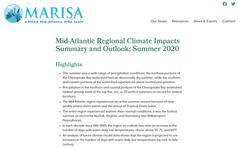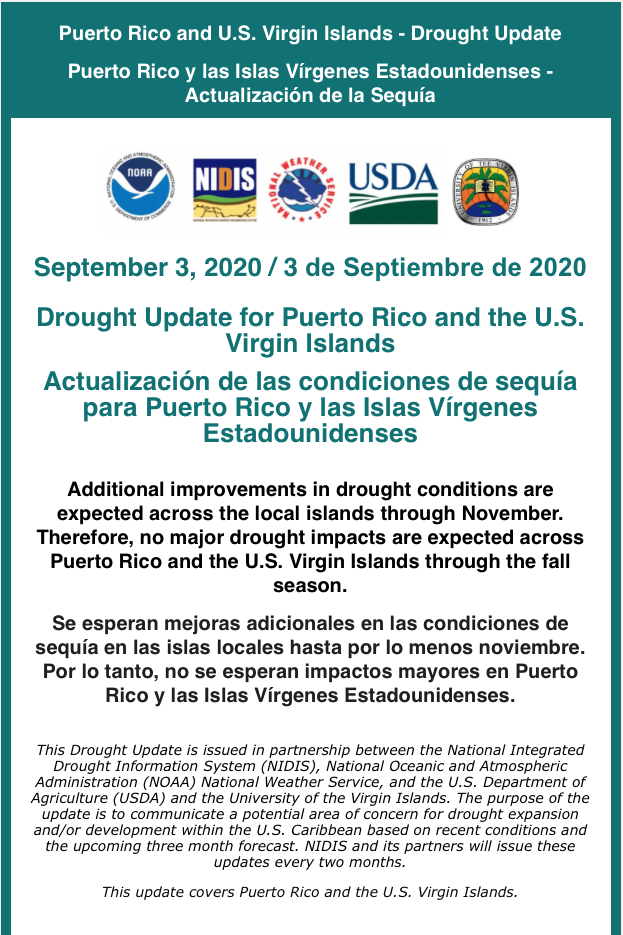Quarterly Climate Impacts and Outlook for the Western Region for June – August 2020. Dated September 2020.
Summer temperatures were well above normal in California, Nevada, the Four Corners and Wyoming. Pacific Northwest and Montana temperatures were near normal or above normal with a few small pockets below normal. Large areas of the West observed a drier than normal summer with southeast California into Arizona being the driest. This is the second year in a row with “missing” monsoon rains.
Quarterly Climate Impacts and Outlook for the Northeast Region for June – August 2020. Dated September 2020.
The Northeast had its third hottest summer at 2.4°F above normal. It was record hot for four states and among the four hottest for seven states. The Northeast saw 92% of normal summer precipitation, ranking in the middle third of all years. It was among the 20 driest for five states but Maryland's 13th wettest.
Quarterly Climate Impacts and Outlook for the Gulf of Maine Region for June – August 2020. Dated September 2020.
Summer was hotter and drier than normal across the region. Caribou and Portland, ME; Kejimkujik (National Park), N.S.; and Moncton, N.B., had their hottest summer on record, while Concord, NH; Yarmouth, N.S.; and Fredericton and St. John, N.B., had one of their five hottest. Charlottetown, P.E.I., and Bas-Caraquet, N.B., had their driest summer on record, while several other sites including Caribou, ME, and Summerside, P.E.I., had one of their five driest.
Quarterly Climate Impacts and Outlook for the Missouri River Basin June – August 2020. Dated September 2020.
Summer 2020 was one of the warmest on record for many states in the region, including CO (3rd), NE (9th), ND (10th), SD (11th), and WY (11th). It was also one of the driest summers for CO (7th), IA (14th), NE (16th), and WY (16th).
Quarterly Climate Impacts and Outlook for the Southern Region for June – August 2020. Dated September 2020.
Temperatures hovered between slightly below normal to slightly above normal for much of the region, with the West experiencing above-normal temperatures. Precipitation varied spatially, with normal to above-normal precipitation in the East and Deep South and below-normal precipitation in the West.
Quarterly Climate Impacts and Outlook for Hawaii and the U.S. Pacific Islands Region for June – August 2020. Dated September 2020.
Includes significant events, regional climate overview, and sectoral impacts for June – August 2020; regional outlook for September – November 2020.
Quarterly Climate Impacts and Outlook for the Chesapeake Bay Region for June – August 2020. Dated September 2020.
The entire region experienced warmer-than-normal conditions; it was the hottest summer on record for Norfolk, Virginia, and Harrisburg and Williamsport, Pennsylvania. This summer saw a wide range of precipitation conditions; the northern portions of the Chesapeake Bay watershed had an abnormally dry summer, while the southern and eastern portions of the watershed experienced above normal precipitation.
Quarterly Climate Impacts and Outlook for the Southeast Region for June – August 2020. Dated September 2020.
Above-average temperatures were recorded over Virginia and Florida, with near-average temperatures reported over the rest of the Southeast. A few stations observed their top 5 wettest summers on record, including Staunton, VA and Hickory, NC. In contrast, parts of Florida and Georgia only had 70 percent of normal summer precipitation.
This drought early warning update was originally sent via email to the Missouri River Basin and Midwest DEWS email lists.
This Puerto Rico and U.S. Virgin Islands drought early warning update was originally sent via email on September 3, 2020.
Additional improvements in drought conditions are expected across the local islands through November. Therefore, no major drought impacts are expected across Puerto Rico and the U.S. Virgin Islands through the fall season.











